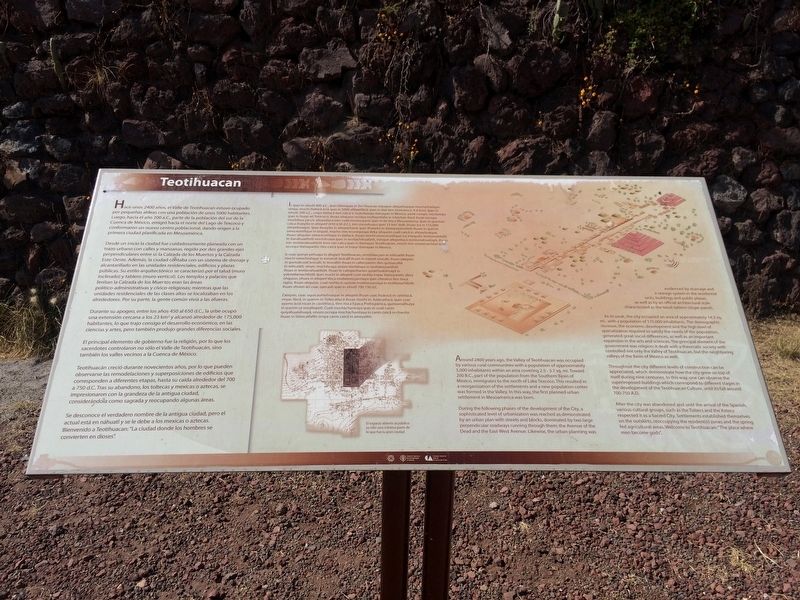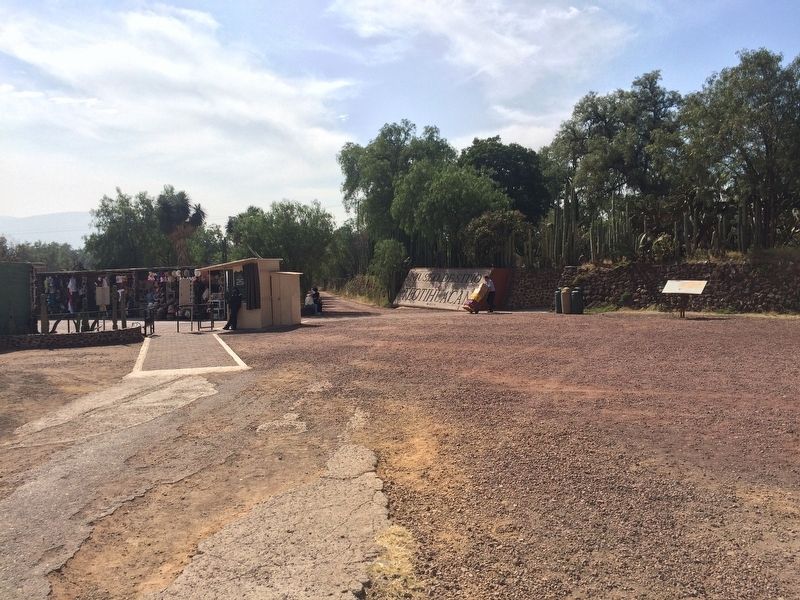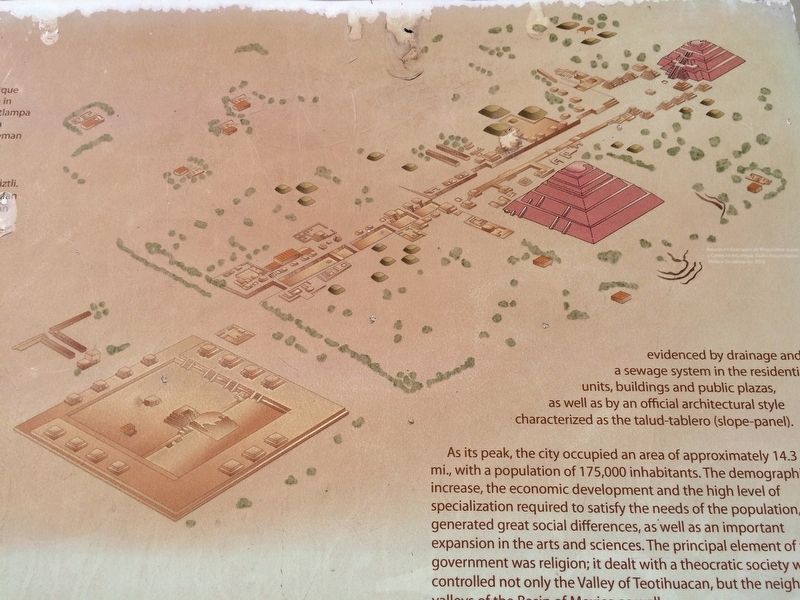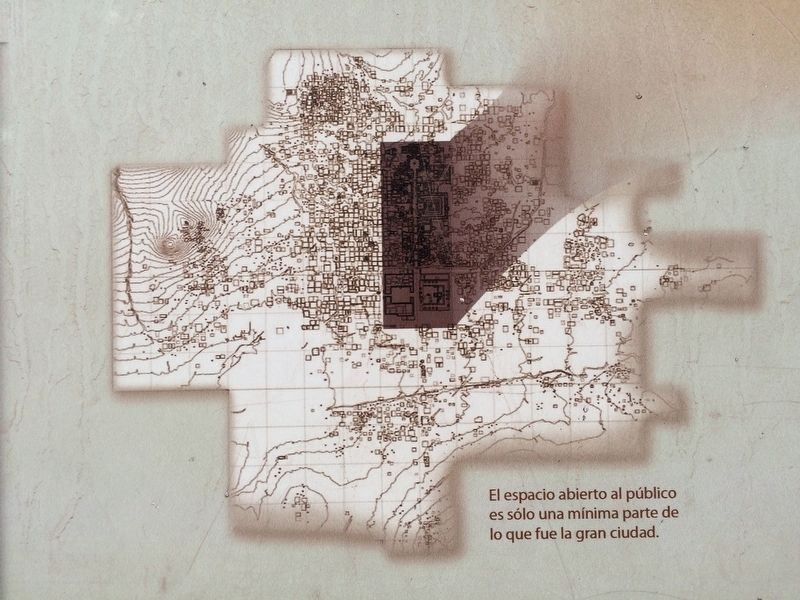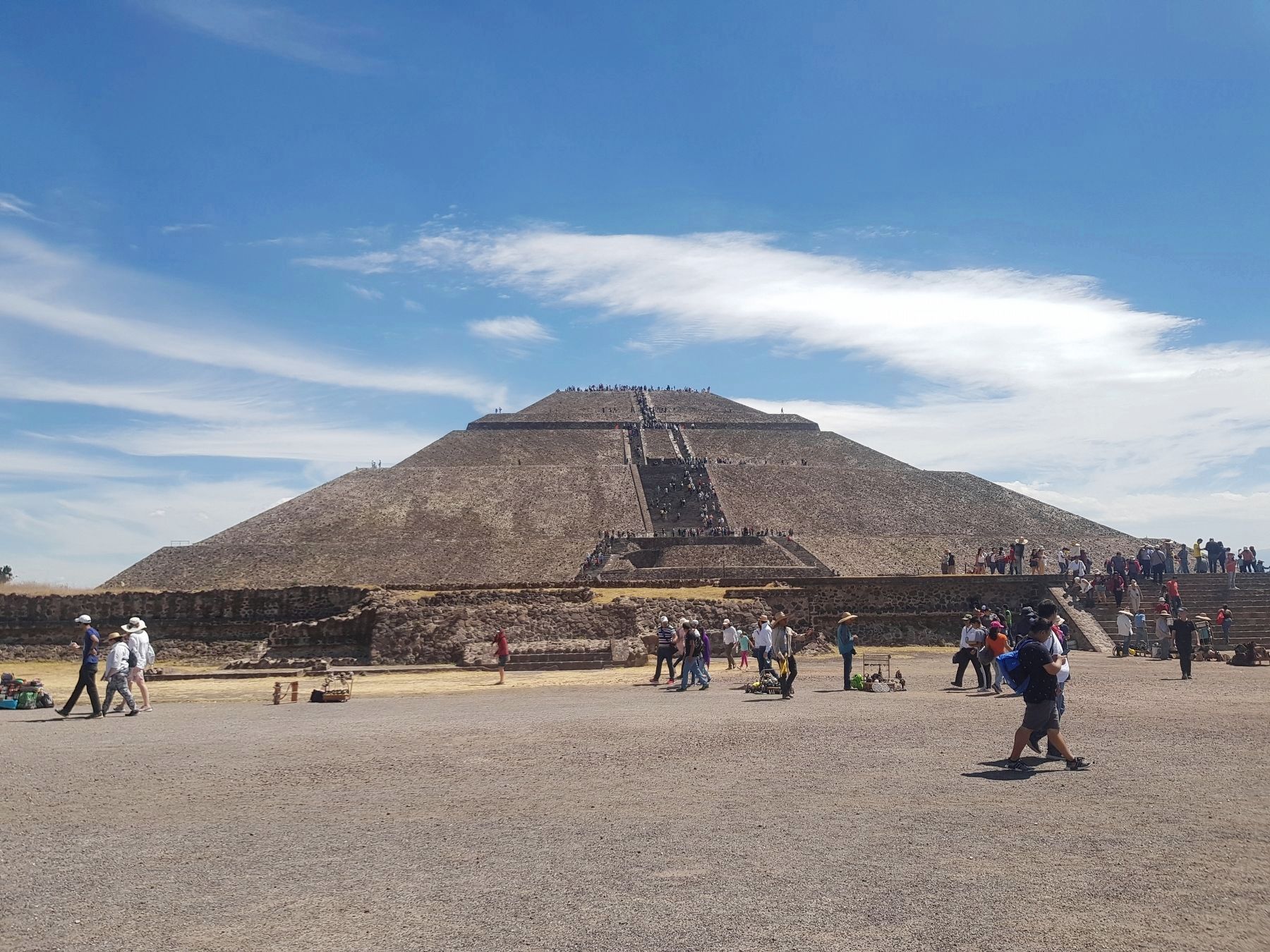Teotihuacán de Arista in Teotihuacán, Mexico State, Mexico — The Central Highlands (North America)
Teotihuacan
Teotihuacan
Hace unos 2400 años, el Valle de Teotihuacan estuvo ocupado por pequenas aldeas con una población de unos 5000 habitantes. Luego, hacia el año 200 a.C., parte de la población del sur de la Cuenca de México, emigró hacia el norte del Lago de Texcoco y conformaron un nuevo centro poblacional, dando origen a la primera ciudad planificada en Mesoamérica.
Desde un inicio la ciudad fue cuidadosamente planeada con un trazo urbano con calles y manzanas, regido por dos grandes ejes perpendiculares entre sí: la Calzada de los Muertos y la Calzada Este-Oeste. Además, la ciudad contaba con un sistema de drenaje y alcantarillado en las unidades residenciales, edificios y plazas públicas. Su estilo arquitectónico se caracterizó por el talud (muro inclinado) y tablero (muro vertical). Los templos y palacios que limitan la Calzada de los Muertos eran las áreas político-administrativas y cívico-religiosas; mientras que las unidades residenciales de las clases altas se localizaban en los alrededores. Por su parte, la gente común vivia a las afueras.
Durante su apogeo, entre los años 450 al 650 d.С., la urbe ocupó una extensión cercana a los 23 km2 y alcanzó alrededor de 175,000 habitantes, lo que trajo consigo el desarrollo económico, en las ciencias y artes, pero también produjo grandes diferencias sociales.
El principal elemento de gobierno fue la religión, por lo que los sacerdotes controlaron no sólo el Valle de Teotihuacán, sino también los valles vecinos a la Cuenca de México.
Teotihuacán creció durante novecientos años, por lo que pueden observarse las remodelaciones y superposiciones de edificios que corresponden a diferentes etapas, hasta su caída alrededor del 700 a 750 d.C. Tras su abandono, los toltecas y mexicas o aztecas, se impresionaron con la grandeza de la antigua ciudad, considerándola como sagrada y reocupando algunas áreas.
Se desconoce el verdadero nombre de la antigua ciudad, pero el actual está en náhuatl y se le debe a los mexicas o aztecas. Bienvenido a Teotihuacan: "La ciudad donde los hombres se convierten en dioses."
Pie de dibujo:
El espacio abierto al público es sólo una mínima parte de lo que fue la gran ciudad.
Teotihuacan
Ic ipan in xihuitl 400 a.C., ipan itlamayan in Teotihuacan miyaque altepehuaque mochachatique ompa, mochi tlatlaca acia ipan in 5000 altepetlaca; ipan in tlali tlen momana ic 4-6 km2. Ipan in xihuiti 200 а.С.,
cequi tlatlaca tlen catca ic huitztlampa tlamayan in Mexico, yawe compic mictlampa ipan in hueyi atl Tetzcoco; ihuan ohquion occepa motlayetlalia in ichàchan tlaca ihuan occepa
mochihua yacuic altepetlacà tlen cuali omotecpanti ipan in tle itoca Mesoamérica. Ipan in queman catca ihueyiliz in altepeti (450-650 d.C.), inin mozohuaya ipan 23 km2 tlalli, ihuan ica in 175,000
altepehuaque. Ipan ihueyiliz in altepechane, ipan ihueyiliz in tlatequipanoliztli ihuan in quenin
omocecetilique in tequitl, mocho inin monequiaya tleka ohquion cuali catca in altepehuaque, ihuan ohquion omocecetilique in tlatlaca, ihuan mochi omocecetilique ica intequiliz teotlamatiliztli. In tlanahuatiliztli mochihuaya ipan in teotlachihualiztli, ininque altepetlaca moteonahuatiaya, ihuan inin teotlanahuatiliztli amo zan catca ipan in tlamayan Teotihuacan, mochi inin omoxinachhui ipan occequi tlamayantin tlen catca ipan in hueyi tlamayan in Mexico.
Ic cuac quinye pehuaya in altepetl Teotihuacan, omotlatecpan in mihcaotli ihuan mochi omochiuhque in tonatiuh teocalli ihuan in metztli teocalli, ihuan zatepan, in quetzalcoatl teocalli. In teocaltin ihuan in caltecpantin tlen quitzacuilia in mihcaòtli, ompic mochihuaya onozo motlaliaya in teotlatecpaniliztli ihuan in teotlanahuatiliztli. Ihuan in caltepechantin quiyehualohuaya in yolotetlamachiliztli. Ipan mochi in altepetl cuali mohta miyac tlatecpantin, tleca ohquion, ohuex in altepetl tleca motlatetecpantiaya ipan chinahui tlen itoca siglos. Ihuan ohquion, cuali mohta in quenin motetecpaniaya in teotlamachiliztli, ihuan ohuion àci cuac oyecauh ipan in xihuitl 700-750 d.C.
Zatepan, cuac oquicauhtehuaque in altepetl ihuan cuac huacico in caltitlaca, miyac tlaca, in quenin in Toltecatlaca ihuan mochi in. Aztecatlaca, ipan cuac ayamo àcia nican in caxtiltlaca, tlen itoca Epoca Prehispánica, quimomalhuiya in quenin ce teoaltepetl. Cuali mochàchantiaya ipan in cuali canin quiyahualohuaya, onozo occepa mochachantiaya in canin catcà in chantin ihuan in tlatocatlallin ompa canin catca in ameyaltin.
Teotihuacan
Around 2400 years ago, the Valley of Teotihuacan was occupied by various rural communities with a population of approximately 5,000 inhabitants within an area covering 2.5-3.7 sq. mi.Toward 200 B.C., part of the population from the Southern Basin of Mexico, immigrates to the north of Lake Texcoco. This resulted in a reorganization of the settlements and a new population center was formed in the Valley. In this way, the first planned urban settlement in Mesoamerica was born.
During the following phases of the development of the City, a sophisticated level of urbanization was reached as demonstrated by an urban plan with streets and blocks, dominated by
two large perpendicular roadways running through them: the Avenue of the Dead and the East-West Avenue. Likewise, the urban planning was evidenced by drainage and a sewage system in the residential units, buildings and public plazas as well as by an official architectural style characterized as the talud-tablero (slope-panel).
As its peak, the city occupied an area of approximately 14.3 sq. mi., with a population of 175,000 inhabitants. The demographic increase, the economic development and the high level of specialization required to satisfy the needs of the population, generated great social differences, as well as an important expansion in the arts and sciences. The principal element of the government was religion; it dealt with a theocratic society with controlled not only the Valley of Teotihuacan, but the neighboring valleys of the Basin of Mexico as well.
Throughout the city different levels of construction can be appreciated, which demonstrate how the city grew on top of itself during nine centuries. In this way, one can observe the superimposed buildings which correspond to different stages in the development of the Teotihuacan Culture, until its fall around 700-750 A.D.
After the city was abandoned and until the arrival of the Spanish, various cultural groups, such as the Toltecs and the Aztecs respected it as a Sacred City. Settlements established
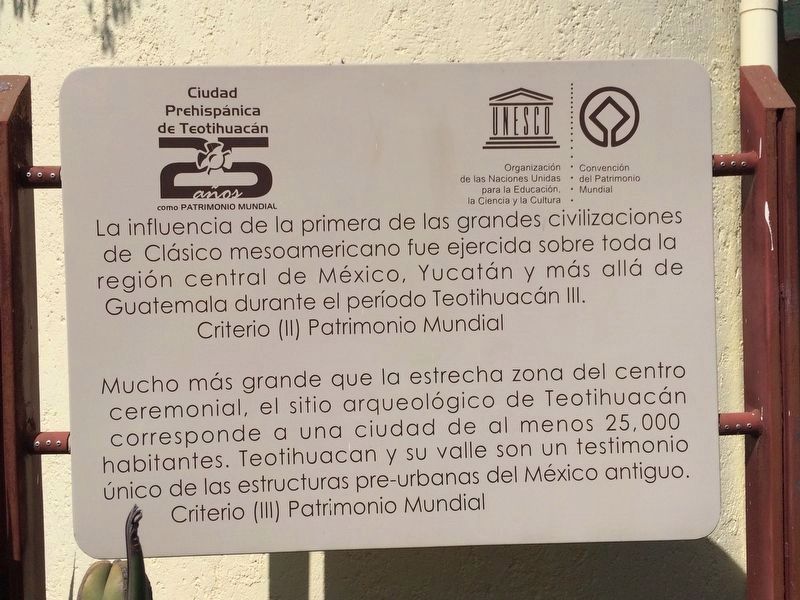
Photographed By J. Makali Bruton, December 2, 2017
5. Teotihuacan as a World Heritage Site Marker
Some steps from the featured marker and outside of the site’s gift shop, this marker notes that Teotihuacan was named a World Heritage Site by UNESCO. It reads:
Ciudad Prehispánica de Teotihuacán
La influencia de la primera de las grandes civilizaciones de Clásico mesoamericano fue ejercida sobre toda la región central de México, Yucatán y más allá de Guatemala durante el período Teotihuacán III.
Criterio (II) Patrimonio Mundial
Mucho más grande que la estrecha zona del centro ceremonial, el sitio arqueológico de Teotihuacán corresponde a una ciudad de al menos 25,000 habitantes. Teotihuacan y su valle son un testimonio único de las estructuras pre-urbanas del México antiguo.
Criterio (III) Patrimonio Mundial
La influencia de la primera de las grandes civilizaciones de Clásico mesoamericano fue ejercida sobre toda la región central de México, Yucatán y más allá de Guatemala durante el período Teotihuacán III.
Criterio (II) Patrimonio Mundial
Mucho más grande que la estrecha zona del centro ceremonial, el sitio arqueológico de Teotihuacán corresponde a una ciudad de al menos 25,000 habitantes. Teotihuacan y su valle son un testimonio único de las estructuras pre-urbanas del México antiguo.
Criterio (III) Patrimonio Mundial
Caption:
The area of the site open to the public is only a small portion of what was once the great city.
Erected by Instituto Nacional de Antropología e Historia (INAH).
Topics and series. This historical marker is listed in these topic lists: Anthropology & Archaeology • Architecture • Native Americans • Settlements & Settlers. In addition, it is included in the UNESCO World Heritage Sites series list.
Location. 19° 41.415′ N, 98° 50.584′ W. Marker is in Teotihuacán de Arista, Estado de Mexico (Mexico State), in Teotihuacán. Marker can be reached from Calle Paloma just west of Calle Tuxpan. Touch for map. Marker is in this post office area: Teotihuacán de Arista MEX 55880, Mexico. Touch for directions.
Other nearby markers. At least 8 other markers are within walking distance of this marker. The Importance of the Pyramid of the Sun (within shouting distance of this marker); The Meaning of the Pyramid of the Sun (about 90 meters away, measured in a direct line); Construction Systems of the Pyramid of the Sun (about 150 meters away); Teotihuacan After Its Abandonment (about 180 meters away); Pyramid of the Sun (approx. 0.3 kilometers away); a different marker also named The Meaning of the Pyramid of the Sun (approx. 0.3 kilometers away); A Ceremonial Incense Burner (approx. 0.4 kilometers away); a different marker also named The Importance of the Pyramid of the Sun (approx. 0.4 kilometers away). Touch for a list and map of all markers in Teotihuacán de Arista.
Credits. This page was last revised on March 24, 2019. It was originally submitted on December 17, 2017, by J. Makali Bruton of Accra, Ghana. This page has been viewed 170 times since then and 20 times this year. Photos: 1, 2, 3, 4, 5. submitted on December 17, 2017, by J. Makali Bruton of Accra, Ghana. 6. submitted on March 24, 2019, by J. Makali Bruton of Accra, Ghana.
